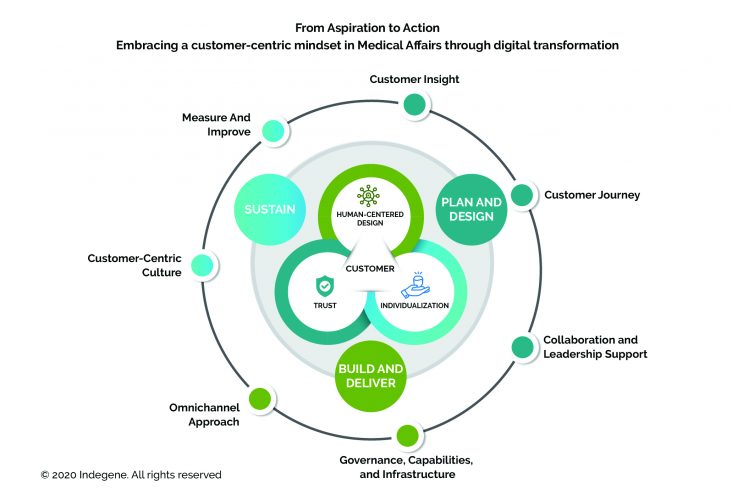Digital agility and customer-centricity – imperatives for Medical Affairs in a post-COVID world
Posted: 19 November 2020 | Mary Alice Dwyer (Medical Affairs Digital Strategy Council), Sameer Lal (Indegene) | No comments yet
Mary Alice Dwyer and Sameer Lal explain how pharmaceutical companies can embrace a more customer-centric approach through digital transformation.


The current pandemic has clearly shifted the balance towards more scientific engagement with physicians. Interactions that are enabled through digital technologies have stood out prominently for being personalised, convenient and rapidly available. These digital opportunities have in turn placed a spotlight upon the key role that plays in addressing a heightened customer expectation.
Medical Affairs is uniquely positioned to take the lead as the non-promotional source for scientific information surrounding medicines. Medical Affairs organisations have taken a significant step towards building digital engagement through the accelerated adoption of digital solutions by field leadership teams during the pandemic as well as the automation of medical information solutions.
With the science behind many medicines becoming increasingly complex, health and care professionals (HCPs) are looking to pharmaceutical companies for high-level non-promotional scientific content and engagement. The focus on personalisation of healthcare delivery and characterisation of individual patients also means there is an increasing need to differentiate based on outcomes to optimise care delivery. HCPs want to have immediate access to content as well as the ability to easily recall it for the future.
This is the backdrop for the whitepaper, From aspiration to action – Embracing a customer-centric mindset in Medical Affairs through digital transformation, developed by the global organisation Medical Affairs Digital Strategy Council,1 that provides solution-oriented insights on how to improve customer experience and what needs to happen at the back-end in a life science enterprise to ensure it will become a sustainable reality.
Siloed lineage – how do we tear down those walls?
Historically, the life science industry has operated with multiple departments and functions, resulting in siloed operations and therefore cost and outcome inefficiencies. Challenges such as a lack of clarity on accountability, functional ‘ownership’ of the customer (HCPs, key opinion leaders, etc), barriers between commercial, R&D and medical have all contributed to the lack of a seamless approach for delivering great customer experiences at scale.


Building effective cross-functional partnerships and breaking down traditional functional silos will enable Medical Affairs to be more impactful by:
- working with marketing and market research to have greater access to and analysis of customer insights
- partnering with legal and compliance to ensure clear and consistent guidelines on how to manage traditional areas of risk
- working with IT teams to create an infrastructure that fosters collaborative working for example, shared customer relationship management (CRM) platforms
- collaborating externally with a wide range of stakeholders with a common purpose to improve customer experience.
Delivering great customer experience – no single definition
It is imperative that the pharmaceutical industry works across all areas to provide a smooth experience for the customer”
Digital evolution is at the core of this transformation with technology rapidly changing business orthodoxies. Customer expectations are increasing as they now expect the same level of customer experience that we get from companies such as Amazon, Apple and Google in every other interaction including healthcare.
In the life sciences industry, there is no single definition of excellent customer experience as it depends on the individual needs of the customer, their expectations and the channel employed. True customer-centricity puts individuals at the centre. It is created for individuals, not markets or segments. The good news is that there is a methodology to achieve this level of individualisation. The Medical Affairs Digital Strategy Council has released three core criteria for delivering good customer experience and interactions in Medical Affairs. These are:
Human-centred design
- inspired and co-developed by the ultimate users
- user experience is instinctive and effortless
- joined up and seamless experience and systems (omnichannel)
- aligned with the user’s workflow with easy and quick access in real-time.
Individualisation
- optimises customer experience for each person
- uses a rich dataset to adapt and adjust the experience for each person
- responsive to the needs of each individual, ensuring geographical and cultural sensitivity and environmental and generational relevance.
Trust
- credible accurate and evidence-based content across all channels
- transparency in how data is obtained and utilised
- reliability of service and speed of response.
Governance, capabilities and infrastructure
Alongside the general mindset shift and technology integration, there needs to be effective governance and compliance with the guardrails that are essential in a regulated industry. Blending teams of traditional medical-scientific backgrounds with emerging skillsets in technology and data is an effective way of achieving this.
In addition to capabilities, investing in infrastructure is key. Only focusing on the front-end experience without changing the back-end operations that support it is unlikely to be sustainable.
Core to delivery is a customer-centered omnichannel approach that involves delivering a data-driven, customer-centric experience that flows seamlessly across channels and devices. As we embark on our digital transformations, we can learn from other industries that have already launched large-scale omnichannel transformations, for example banking, where the widespread adoption of digital service channels and telecommunications has resulted in 44 percent of all consumer requests now being handled through digital channels.3


Credit: Medical Affairs Digital Strategy Council.
Customer-centric culture: measure and improve
The key to satisfying customers is not just to measure what happens but also to use the data to drive action throughout the organisation.4 Establishing and reporting on metrics is of paramount importance for digital to be fully entrenched within an organisation. There are various measurement models available that can be used as a reference point – examples include: CXQ (Customer Experience Quotient),5 CXV (Customer Experience Value)6 and ROX (Return on experience).7
Key challenges
Regulatory constraints were cited by the members of the Medical Affairs Digital Strategy Council as the main barrier restricting the uptake of digital solutions. The following positive steps were recommended to evolve the regulatory environment by:
- establishing the trust that is essential amongst the regulatory authorities, customers and the public
- having a united voice as ‘one industry’ when negotiating with regulatory authorities
- creating internal awareness and understanding of how regulations have progressed and challenging traditional interpretations that are not factually based
- having the courage to do things differently and take the risk
- evolving our positioning amongst regulators as a ‘provider of products’ to a ‘provider of services’.
An exciting future ahead
The COVID-19 crisis been an opportunity for Medical Affairs to rise to the challenge and take a leadership role in ensuring fast, efficient and meaningful responses to all stakeholders at a time of intense pressure.
This is a marathon, not a sprint, that requires long-term investment and commitment from leadership. The time is right to move from aspiration to action and drive the change that needs to happen to put the customer first and foremost in everything we do within Medical Affairs.
About the authors




References
- The Medical Affairs Digital Strategy Council was set-up with the vision to help medical affairs organizations embrace technology and innovation through a digital and data-driven model to further unlock growth and maximize impact across internal and external engagements. It serves to bring together leaders from the industry to evaluate practical applications of modern technology for increasing the efficiency of the organization, enhancing communication, and improving compliance. This initiative is supported by Indegene.
- Bain. Customer Experience Tools and Trends 2018
- McKinsey & Company. Omnichannel consumer interactions – a payer perspective. June 2019
- McKinsey & Company. Creating value through transforming customer journeys. Winter 2016.
- DT Consulting. https://dt-consulting.com/customer-experience-quotient-cxq/
- Deloitte Consulting https://www2.deloitte.com/content/dam/Deloitte/us/Documents/process-and-operations/us-cons-the-true-value-of-customer-experiences.pdf
- PwC. https://www.pwc.com/gx/en/consumer-markets/consumer-insights-survey/2019/report.pdf
Related topics
Big Pharma, Industry Insight, Informatics, QA/QC, Technology
Related organisations
Amazon, Apple, Google, Medical Affairs Digital Strategy Council









